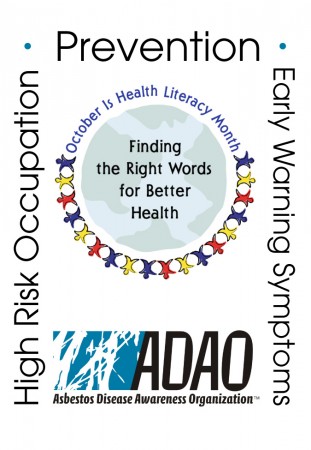Part One: Preventing Asbestos-Caused Diseases
Part Two: High Risk Occupations
Part Three: Understand the Warning Symptoms for Asbestos-Caused Diseases
Posted on October 27, 2014
 October is Health Literacy Month, and at the Asbestos Disease Awareness Organization (ADAO) that means understanding how dangerous asbestos is and seeking medical help when a loved one might have been exposed. Everyone should know the Irrefutable Facts About Asbestos because the only two ways to end asbestos-caused diseases are prevention and a cure. Our theme is “Be a Health Literacy Hero,” so be a hero and share this blog with your social networks.
October is Health Literacy Month, and at the Asbestos Disease Awareness Organization (ADAO) that means understanding how dangerous asbestos is and seeking medical help when a loved one might have been exposed. Everyone should know the Irrefutable Facts About Asbestos because the only two ways to end asbestos-caused diseases are prevention and a cure. Our theme is “Be a Health Literacy Hero,” so be a hero and share this blog with your social networks.
This year we encourage you to join our “Make a Pie – Take A Pie… Ban Asbestos!” Challenge to spread awareness, and have fun. Click here for the details and to see videos of people who have participated (including Linda Reinstein).
A 2013 NIOSH study found that firefighters are twice as likely to die of mesothelioma as the general population. Mesothelioma is a fatal cancer caused by asbestos exposure, which is also linked to asbestosis, lung and gastrointestinal cancers. Inhaling asbestos fibers can cause permanent and irreversible damage to vital organs. Typically, disease occurs 10 – 50 years after exposure. Early detection is often difficult; asbestos-related disease symptoms are generally vague and can be easily confused with other illnesses, such as pneumonia. Only a doctor can properly diagnose asbestos-related diseases. Your doctor will ask you about possible occupational or environmental asbestos exposure.
According to the National Cancer Institute, you should contact your doctor immediately if you experience any of the following symptoms:
- A persistent cough that gets worse over time
- Blood in the sputum (fluid) coughed up from the lungs
- Pain or tightening in the chest
- Difficulty swallowing
- Swelling of the neck or face
- Loss of appetite
- Weight loss
- Fatigue or anemia
The above symptom list is from the National Cancer Institute Fact Sheet “Asbestos Exposure and Cancer Risk.” Please note, however, that not all asbestos exposure or disease leads to cancer.
Important Notice: ADAO does not make medical diagnoses, recommend treatment, or answer specific patient questions. Specific concerns should be addressed directly by your treating physician.
If you or a loved one is diagnosed with an asbestos-caused disease, you are not alone. Join other asbestos patients and families at our 11th Annual Asbestos Awareness Conference, April 17-19, 2015 in Washington, D.C., where renowned experts, global activists, scientists, and doctors will discuss the latest advancements in disease prevention, global advocacy, and treatment for mesothelioma and other asbestos-caused diseases. Together, change is possible.
This is Part Three of our 3-part Health Literacy Month Series. Click to read Part One: Prevention, and Part Two: High Risk Occupations.
In unity,
Linda Reinstein[/fusion_builder_column][/fusion_builder_row][/fusion_builder_container]
